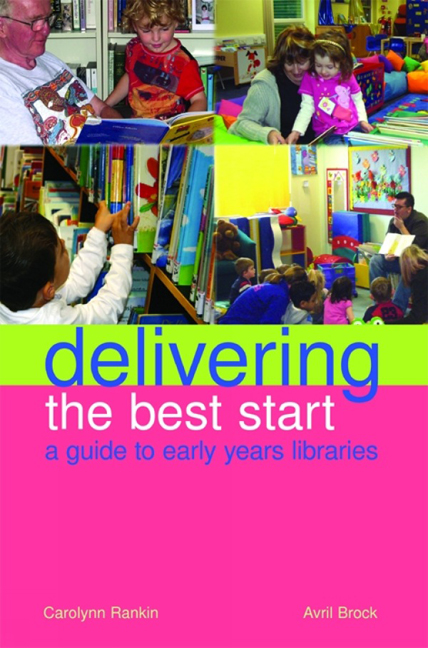Book contents
- Frontmatter
- Contents
- Preface
- Introduction
- Acknowledgements
- 1 Take them to the library – setting the scene
- 2 People and partnerships, skills and knowledge
- 3 Buildings, design and space
- 4 Resources for early years libraries – books, toys and other delights
- 5 Reaching your audience – the librarian's role
- 6 Planning
- Appendix: Early Years Library Services fit with central provision
- References
- Index
5 - Reaching your audience – the librarian's role
Published online by Cambridge University Press: 08 June 2018
- Frontmatter
- Contents
- Preface
- Introduction
- Acknowledgements
- 1 Take them to the library – setting the scene
- 2 People and partnerships, skills and knowledge
- 3 Buildings, design and space
- 4 Resources for early years libraries – books, toys and other delights
- 5 Reaching your audience – the librarian's role
- 6 Planning
- Appendix: Early Years Library Services fit with central provision
- References
- Index
Summary
Introduction
In this chapter we look at how the early years librarian can provide opportunities for young children and their families to enjoy literacy and language development activities together. In the UK the library service can be regarded as a key partner acting as a bridge to the community by providing a welcoming atmosphere. We discuss introducing a love of books to babies and young children and the role of stories and storytelling in helping to develop the imagination. Many early years librarians tell stories at sessions, providing entertainment and enlightenment for their local community. Acknowledging the skills required to effectively connect and engage with a family audience, we offer practical guidance for the librarian as performer. Continuing the theme of partnerships we discuss three examples of outreach work by looking at Traveller families, teenage fathers and culturally diverse communities. Partnerships are a key aspect of campaigns and promotional schemes and we look at some UK-based initiatives. The final section includes an example of programmes in use in Australia and the USA to provide library-based services to babies, young children and their families.
Providing a welcoming atmosphere
Librarians want to reach the family audience so as to encourage literacy skills and help build sustainable communities. The well planned early years library will provide a range of wonderful books, toys, treasure baskets and other creative resources for young users and their families. The environment in which these resources are offered also merits consideration, as audiences can be encouraged by sending positive messages. The early years librarian has an important role in helping children, and the adults with them, to feel comfortable and welcome in the library or early years setting. In planning a welcoming environment, children's craft and art work displayed on the walls can encourage links with the local community. In Chapter 3 we discussed how the physical aspects of the library can be planned to create a positive environment. In addition to the physical environment, the social atmosphere and ethos created by the library staff is an important factor in making families feel welcome. Encourage your colleagues to consider their behaviour and the non-verbal messages they send, particularly when feeling concerned about something. It can be difficult to show relaxed, positive body language all the time. It would be useful to promote discussions with other colleagues about how to manage certain challenging situations.
- Type
- Chapter
- Information
- Delivering the Best StartA Guide to Early Years Libraries, pp. 113 - 144Publisher: FacetPrint publication year: 2013



